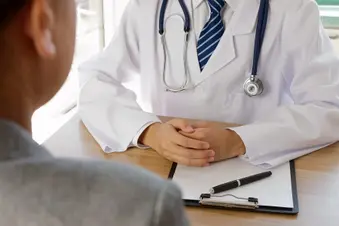
By Shaini Saravanamuthu, as told to Kara Mayer Robinson
When I found out I have retinitis pigmentosa (RP), a type of inherited retinal dystrophy, I was shocked.
Nobody in my family has vision problems. I had some trouble with my vision, but I thought it was because of bad lighting or simply because eyes weren’t meant to see well in the dark.
After my diagnosis, my struggle to see at night made sense.
My Diagnosis
I discovered I had retinitis pigmentosa after I switched to a new optometrist. He caught it in a routine check-up. He had taken a picture of my retina and saw pigment deposits.
My optometrist referred me to an ophthalmologist right away. I did several visual field tests and had scans of my retina. My doctor asked questions about my vision and when I noticed symptoms. They also asked about my family history.
I have a South Asian background. My family is from a country where they didn’t have medical records and didn’t talk openly about illnesses or disabilities. This made it difficult to know if anyone in my family suffered from eye diseases or vision loss.
I only really got an idea after I had genetic testing. I found out both my parents were carriers. They told me that a gene had mutated, and that’s how I got RP. My gene mutation still hasn’t been identified, but I did find out that I won’t pass it down to my kids, which is a relief.
I saw two different ophthalmologists before I got the final diagnosis. I was told I’d need a specialist to follow me and track the condition. My doctors said that as time passed, I’d lose more vision. They told me to be patient, take vitamins, and hope for the best. They also said there was no cure.
What Will My Future Be Like?
Finding out I had RP was heartbreaking and terrifying. My main concern was how quickly my vision loss would happen. I wanted to know if there were any treatments to reverse it. I also worried about passing it down to my future kids. I had a lot of questions. Would I be able to continue my normal life? What will happen to my career? How will dating look?
That was in 2011. But it’s a whole different ball game now. There are so many more studies and clinical trials being done and there’s more awareness about inherited retinal dystrophy. There’s much more hope now.
The science and technology side of it is very exciting. Even if it’s not in my lifetime, I’m pretty confident that in the next few generations, people who are diagnosed won’t have to hear the horrible words, “Sorry, there’s no treatment for RP.”
Living With Retinal Dystrophy
At age 31, I’m now legally blind and a person with a disability. I have severe night blindness and limited peripheral vision.
In 2020, I discovered a hole in my right eye that created more vision problems. My doctors were able to patch the hole using an amniotic membrane. The vision hasn’t come back, but the risk of a retinal detachment is gone. I’m hoping the lost vision from the hole slowly comes back.
Now I just take it day by day. I do better during the day and in well-lit places. My biggest struggle is at night or in low light, where I don’t see at all. I have trouble with stairs, so I take my time, especially when I go down any stairs in public places.
I work off my memory a lot. Memory and flashlights are my best friends.
So are my friends and family. They’re a huge support. They help guide me in the dark and bring me places when public transportation isn’t an option. I no longer have a driver’s license, so it’s a big help.
When I go out, I usually go with my sister or friends. I’ll stick to places where I’ve already been and where I’m comfortable using public transportation by myself. I’m planning to learn how to use a white cane, which is a mobility device, to get my independence and confidence back in dark settings.
A Brighter Outlook
It’s getting better with time. It took me about 4 years to embrace this new journey, with the help of my therapist and my genetic counselor.
Joining online support groups, like those on Facebook, and following people on social media who are thriving with vision loss have been a big help. I love the community I’ve come to know across the world. Our visually impaired community is so strong and resilient. It’s very inspiring.
It may seem like everything is going wrong when you first get a diagnosis, but with time you can learn to embrace the journey. This diagnosis led me to a whole new community that I wasn’t aware of, and it has opened my eyes, no pun intended, to so much.
I’m grateful for my journey and can’t wait to see how much more the vision research world will grow and innovate in the coming years. My advice to others is to have faith and take it day by day.
Show Sources
Photo Credit: daizuoxin / Getty Images
SOURCES:
Shaini Saravanamuthu, Montreal, Canada.
American Academy of Ophthalmology: Chronic Macular Hole Repair with Human Amniotic Membrane Graft.”
Lions Eye Institute: “Eye Health Information: Retinal Dystrophy.”
NIH: “Retinitis Pigmentosa.”